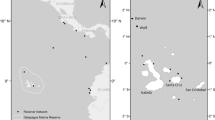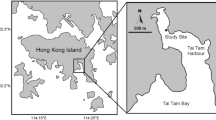Abstract
The carnivorous snail Adelomelon ancilla usually carries, attached to its shell, the anemone Antholoba achates, which also lives attached to hard substrates in the same area. Interaction between both species was studied by stable isotopes analyses (SIA), direct observations, and analysis of gut contents. Results did not show evidences of dietary overlap between anemones and snails. A. ancilla consumed mainly bivalves and secondarily gastropods. The diet of A. achates involved sea urchins and echiurids as main prey. The trophic niches of anemones and snails did not overlap; the species had similar δ15N values but differences in their δ13C values. Sessile and epibiotic anemones also showed differences in their δ13C means, revealing access to different resources. Whereas SIA provided information on trophic relationships and structure, observation of feeding events provided details of prey utilization patterns. Combining direct and indirect approaches helps to overtake method weaknesses and greatly improve dietary descriptions.






Similar content being viewed by others
References
Acuña FG, Excoffon AC, Scelzo MA (2003) Mutualism between the sea anemone Antholoba achates (Drayton, 1846) (Cnidaria: Actiniaria: Actinostolidae) and the spider crab Libinia spinosa Milne-Edwards, 1834 (Crustacea: Decapoda, Majidae). Belg J Zool 133:85–87
Benstead JP, March JG, Fry B, Ewel KC, Pringle CM (2006) Testing IsoSource: stable isotope analysis of a tropical fishery with diverse organic matter sources. Ecology 87:326–333
Bertness MD, Leonard GH (1997) The role of positive interactions in communities: lessons from intertidal habitats. Ecology 78:1976–1989
Bertness MD, Leonard GH, Levine JM, Schmidt PR, Ingraham AO (1999) Testing the relative contribution of positive and negative interactions in rocky intertidal communities. Ecology 80:2711–2726
Bigatti G, Penchaszadeh PE, Cledon M (2007) Age, growth and somatic production in the volutid gastropod Odontocymbiola magellanica from Golfo Nuevo, Patagonia Argentina. Mar Biol 150:1199–1204
Bigatti G, Sánchez Antelo CJM, Miloslavich P, Penchaszadeh PE (2009) Adelomelon ancilla: a predator neogastropod in Patagonian benthic communities. Nautilus 123:159–165
Botto F, Bremec C, Marecos A, Schejter L, Lasta M, Iribarne O (2006) Identifying predators of the SW Atlantic Patagonian scallop Zygochlamys patagonica using stable isotopes. Fish Res 81:45–50
Brett MT, Müller-Navarra DC (1997) The role of highly unsaturated fatty acids in aquatic food-web processes. Freshwater Biol 38:483–499
Brooks WR, Mariscal RN (1986) Population variation and behavioral changes in two pagurids in association with the sea anemone Calliactis tricolor (Lesueur). J Exp Mar Biol Ecol 103:275–289
Bruno JF, Stachowicz JJ, Bertness MD (2003) Inclusion of facilitation into ecological theory. Trends Ecol Evol 18:119–125
Cahu CL, Cuzonf G, Quazuguel P (1995) Effect of highly unsaturated fatty acids, cx-tocopherol and ascorbic acid in broodstock diet on egg composition and development of Penaeus indicus. Comp Biochem Physiol A 112A:417–424
Castellanos ZJA, Landoni N (1992) Catálogo descriptivo de la malacofauna marina magallánica 10. Neogastropoda, Volutidae, Volutomitridae, Cancellariidae, Olividae y Marginellidae. La Plata. Comisión de Investigaciones Científicas de la Provincia de Buenos Aires (CIC) 10:1–43
Cheng-Tze H, Shuh-Ji K, Chang-Feng D, Hwey-Lian H, Fuh-Kwo S, Rong-Quen J (2007) Dietary separation between two blennies and the Pacific Gregory in northern Taiwan: evidence from stomach content and stable isotope analyses. Mar Biol 151:729–736
Crawley MJ (2007) The R book. Wiley, Chichester
Curio E (1976) The ethology of predation: zoophysiology and ecology. Springer, New York
Díaz E, Kraufvelin P, Erlandsson J (2012) Combining gut fluorescence technique and spatial analysis to determine Littorina littorea grazing dynamics in nutrient-enriched and nutrient-unenriched littoral mesocosms. Mar Biol 159:837–852
Dubois S, Jean-Louis B, Bertrand B, Lefebvre S (2007) Isotope trophic-step fractionation of suspension-feeding species: implications for food partitioning in coastal ecosystems. J Exp Mar Biol Ecol 351:121–128
Duffy DC, Jackson S (1986) Diet studies of seabirds: a review of methods. Colon Waterbirds 9:1–17
Flaherty EA, Ben-David M (2010) Overlap and partitioning of the ecological and isotopic niches. Oikos 119:1409–1416
Galván DE, Sweeting CJ, Polunin NVC (2012) Methodological uncertainty in resource mixing models for generalist fishes. Oecologia 169:1083–1093
Hughes RN (1993) Diet Selection: an interdisciplinary approach to foraging behaviour. Blackwell Scientific Publications, Oxford
Hyslop EJ (1980) Stomach contents analysis, a review of methods and their application. J Fish Biol 17:411–429
Inger R, Ruxton GD, Newton J, Colhoun K, Robinson JA (2006) Temporal and intrapopulation variation in prey choice of wintering geese determined by stable isotope analysis. J Anim Ecol 75:1190–1200
Jackson AL, Inger R, Bearhop S (2009) Erroneous behaviour of MixSIR, a recently published Bayesian isotope mixing model: a discussion of Moore and Semmens (2008). Ecol Lett 12:E1–E5
Jackson AL, Inger R, Parnell A, Bearhop S (2011) Comparing isotopic niche widths among and within communities: SIBER—Stable Isotope Bayesian Ellipses R. J Anim Ecol. doi:10.1111/j.1365-2656.2011.01806.x
Jackson MC, Donohue I, Jackson AL, Britton JR, Harper DM, Grey J (2012) Population-level metrics of trophic structure based on stable isotopes and their application to invasion ecology. PLoS One 7:e31757
Kurle CM, Sinclair EH, Edwards AE, Gudmundson CJ (2011) Temporal and spatial variation in the δ15N and δ13C values of fish and squid from Alaskan waters. Mar Biol 158:2389–2404
Lajtha K, Michener RH (1994) Stable isotopes in ecology and environmental science. Blackwell Scientific, Oxford
Layman CA, Araujo MS, Boucek R, Hammerschlag-Peyer CM, Harrison E, Jud ZR, Matich P, Rosenblatt AE, Vaudo JJ, Yeager LA, Post DM, Bearhop S (2012) Applying stable isotopes to examine food-web structure: an overview of analytical tools. Biol Rev 87:545–562
Luzzatto D, Pastorino G (2006) Adelomelon brasiliana and Antholoba achates: a phoretic association between a volutid gastropod and a sea anemone in Argentine waters. Bull Mar Sci 78:281–286
McKnight J (2009) Trophic enrichment patterns of δ13C in organic matter of molluscan shell: implications for reconstructing ancient environments and food webs. Master thesis Department of Geology College of Arts and Sciences, University of South Florida
McLean RB, Mariscal RN (1973) Protection of a hermit crab by its symbiotic sea anemone Calliactis tricolor. Experientia 29:128–130
Moore JW, Semmens BX (2008) Incorporating uncertainty and prior information into stable isotope mixing models. Ecol Lett 11:470–480
Munguia P, Ojanguren AF, Evans AN, Ryckman L, Gemmell B, Cook C, Hensgen G (2009) Is facilitation a true species interaction? Open Ecol J 2:83–85
Newsome SD, Tinker MT, Monson DH, Oftedal OT, Ralls K, Staedler MM, Fogel ML, Estes JA (2009) Using stable isotopes to investigate individual diet specialization in California sea otters (Enhydra lutris nereis). Ecology 90:961–974
Nordström MC, Lindblad P, Aarnio K, Bonsdorff E (2010) A neighbour is a neighbour? Consumer diversity, trophic function, and spatial variability in benthic food webs. J Exp Mar Biol Ecol 391:101–111
Paine RT (1988) On food webs: roadmaps of interactions or grist for theoretical development. Ecology 69:1648–1654
Paradis M, Ackman RG (1977) Potential for employing the distribution of anomalous non-methylene-interrupted dienoic fatty acids in several marine invertebrates as part of food web studies. Lipids 12:170–176
Parnell A, Inger R, Bearhop S, Jackson AL (2010) Source partitioning using stable isotopes: coping with too much variation. PLoS One 5:e9672
Pastorino G (1993) The association between the gastropod Buccinanops cochlidium (Dillwyn, 1817) and the sea anemone Phlyctenanthus australis Carlgren, 1949 in Patagonian shallow waters. Nautilus 106:152–154
Peterson BJ, Fry B (1987) Stable isotopes in ecosystem studies. Ann Rev Ecol Syst 18:293–320
Phillips DL, Gregg JW (2003) Source partitioning using stable isotopes: coping with too many sources. Oecologia 136:261–269
Pielou EC (1966) The measurement of diversity in different types of biological collections. J Theor Ecol 63:131–144
Rees WJ (1967) A brief survey of the symbiotic associations of Cnidaria with Mollusca. Presidential address. Proc Malacol Soc Land 37:213–231
Ripley B (2005). Boot: Bootstrap R (S-Plus) Functions (Canty). R package Version 1.2-24. Available at http://cran.r-project.org/
Ross DM (1960) The association between the hermit crab Eupagurus bernhardus (L.) and the sea anemone Calliactis parasitica (Couch). Proc Zool Soc Lond 134:43–57
Ross DM (1974) Behavior patterns in associations and interactions with other animals. In: Muscatine L, Lenhoff HM (eds) Colenterate biology. Academic Press, New York, pp 281–312
Ross DM, Kikuchi T (1976) Some symbiotic associations between anemones and gastropods in Japan. Publ Amakusa Mar Biol Lab 4:41–50
Samelius G, Alisauskas RT, Hobson KA, Lariviere S (2007) Prolonging the arctic pulse: long-term exploitation of cached eggs by arctic foxes when lemmings are scarce. J Anim Ecol 76:873–880
Schindler DE, Lubetkin SC (2004) Using stable isotopes to quantify material transport in food webs. In: Polis GA, Power ME, Huxel GR (eds) Food webs at the landscape level. The University of Chicago, Chicago, pp 25–42
Sih A (1993) Effects of ecological interactions on forager diets: competition, predation risk, parasitism and prey behavior. In: Hughes RN (ed) Diet selection: an interdisciplinary approach to foraging behaviour. Blackwell Scientific Publications, Oxford, pp 182–223
Stachowicz JJ (2001) Mutualism, facilitation, and the structure of ecological communities. Bioscience 51:235–246
Sydeman WJ, Hobson KA, Pyle P, Mclaren EB (1997) Trophic relationships among sea–birds in central California: combined stable iso- tope and conventional dietary approach. Condor 99:327–336
Taylor JD, Morris NJ, Taylor CN (1980) Food specialization and the evolution of predatory prosobranch gastropods. Palaeontology 23:375–409
Thomson JA, Heithaus MR, Burkholder DA, Vaudo JJ, Wirsing AJ, Dill LM (2012) Site specialists, diet generalists? Isotopic variation, site fidelity, and foraging by loggerhead turtles in Shark Bay, Western Australia. Mar Ecol Prog Ser 453:213–226
Tirasin EM, Jorgensen T (1999) An evaluation of the precision of diet description. Mar Ecol Prog Ser 182:243–252
Turner TF, Collyer ML, Krabbenhoft TJ (2010) A general hypothesis-testing framework for stable isotope ratios in ecological studies. Ecology 91:2227–2233
Vander Zanden MJ, Rasmussen JB (2001) Variation in d15N and d13C trophic fractionation: implications for aquatic food web studies. Limnol Oceanogr 46:2061–2066
Vander Zanden M, Lester N, Shuter B, Rasmussen J (1999) Patterns of food chain length in lakes: a stable isotope study. Am Nat 154:406–416
Acknowledgments
This work was partially supported by PICTR 01869, PICT 0323, PIP 051 (to G.B.), PICT 01272 and PIP 112-200801-00174 (o O.I.), and a grant from PADI FOUNDATION and a Doctoral Fellowship by CONICET to S.Z. We thank J. Rua, N. Ortiz, R. Vera, and F. Quiroga for field assistance and Dr. Greg Herbert for providing literature and helpful comments.
Author information
Authors and Affiliations
Corresponding author
Additional information
Communicated by P. Kraufvelin.
Rights and permissions
About this article
Cite this article
Zabala, S., Bigatti, G., Botto, F. et al. Trophic relationships between a Patagonian gastropod and its epibiotic anemone revealed by using stable isotopes and direct observations. Mar Biol 160, 909–919 (2013). https://doi.org/10.1007/s00227-012-2143-y
Received:
Accepted:
Published:
Issue Date:
DOI: https://doi.org/10.1007/s00227-012-2143-y




